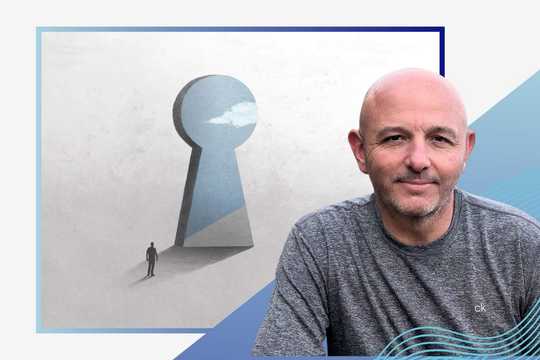Many people are turning to less conventional healing practices for their mental health that go beyond surface-level solutions. Two of the most intriguing — and transformative — approaches gaining attention right now are Holotropic Breathwork and psychedelic therapy. Both offer profound pathways to self-discovery, trauma release, and emotional integration.
Rooted in non-ordinary states of consciousness, practices like Holotropic Breathwork and psychedelic therapy challenge the conventional talk therapy model and invite us into deeper, often spiritual territory. Psychedelic Support spoke with Michael Rapp, MD, PhD, about the parallels between Holotropic Breathwork and psychedelic therapy.
“Participants often report increased self-awareness and noticeable shifts in their personality, including greater emotional flexibility and improved temperament.”
— Katharine Chan, MSc, BSc, PMP
Dr Rapp is a psychiatrist, psychotherapist, and professor in Social and Preventive Medicine at the University of Potsdam. His academic work intersects with his clinical interest in the transformative potential of non-ordinary states of consciousness.
Grounded in the principles of transpersonal psychology, which builds upon the analytical psychology of C.G. Jung, Dr Rapp incorporates non-ordinary states of consciousness into his therapeutic work. This approach includes mystical experiences, spiritual awakenings, and encounters facilitated by practices like Holotropic Breathwork and psychedelic exploration. He views these experiences as gateways to a more integrated and expansive sense of self, where meaningful dialogue can occur between conscious and unconscious aspects of the psyche.
Dr Rapp is currently undergoing advanced training in Holotropic Breathwork facilitation through the Grof Transpersonal Training, further enriching his capacity to support clients in their inner journeys toward healing and transformation.
Whether you’re a curious first-timer or a seasoned psychonaut, this article will explore how breath and medicine can open the door to healing in ways that defy language — and just might change your life.
What is Holotropic Breathwork?
Holotropic Breathwork is a powerful technique that utilizes rapid, rhythmic breathing to help individuals access non-ordinary states of consciousness and promote deep emotional healing. Developed in the 1970s by psychiatrist Stanislav Grof, MD, and his late wife Christina, at the Esalen Institute in Big Sur, California, Holotropic Breathwork draws on their background in psychoanalytic therapy and their interest in how non-ordinary states could support psychological growth and transformation.
Rather than relying solely on traditional talk therapy, the Grofs explored how the mind could shift through deep inner experiences. They discovered that rapid or intensified breathing — similar to what someone might experience during panic or intense emotion — could create profound shifts in consciousness and unlock healing potential in the brain.
The term holotropic comes from the Greek words holos (meaning “whole”) and trepein (“to move toward”). Together, it translates to “moving toward wholeness,” which describes the intention behind this practice. Holotropic Breathwork invites participants to tap into dream-like states, allowing access to buried emotions, memories, and insights often out of reach in everyday awareness.
Through this non-ordinary state of consciousness, people can explore unresolved trauma, repressed emotions, and unconscious patterns. The goal is to promote emotional release, self-awareness, and psychological integration. It’s not uncommon for participants to encounter visionary or spiritual experiences that lead to profound personal transformation.
Principles of Holotropic Breathwork
According to Stanislav and Christina Grof’s Principles of Holotropic Breathwork, the practice combines intensified breathing, evocative music, and body-based energy release techniques to guide participants into deep inner journeys. This approach encourages personal healing by creating a safe and supportive space for accessing non-ordinary states of consciousness.
What Happens in a Holotropic Breathing Session?
Each session typically begins with a thorough orientation. Participants learn about the different types of experiences that may arise, ranging from personal memories and birth-related (perinatal) events to transpersonal or spiritual encounters. Facilitators also review essential safety considerations, including physical and emotional contraindications, and may consult experts if any concerns arise.
“The goal is to promote emotional release, self-awareness, and psychological integration.”
— Katharine Chan, MSc, BSc, PMP
Once prepared, participants lie down and begin deep, accelerated breathing without specific instructions about pace or rhythm. The breathing alone, combined with carefully selected music, helps shift awareness into a powerful state. Music plays a central role — it starts with stirring, energetic tones, builds to an emotional peak, and then tapers off into meditative, calming sounds to support integration.
Throughout the session, facilitators pair participants with “Sitters” — partners who hold space, ensure safety, and provide support as needed. Sitters stay present but non-intrusive, stepping in only to offer basic assistance, such as getting water or guiding someone to the bathroom. They do not offer interpretations or advice, allowing each experience to unfold naturally and authentically.
Facilitated Bodywork and Energy Release
If emotional or physical tension lingers after the breathing session, facilitators may offer bodywork. This hands-on support helps release blocked energy by encouraging the participant to stay present in the area of discomfort and fully express whatever arises. This energy-release process is key to completing and integrating the experience.
Ethical Practice and Boundaries
Because Holotropic Breathwork can evoke intense projections and emotional vulnerability, facilitators must remain aware of the power dynamics at play. Ethical guidelines ensure that facilitators hold a safe, respectful, and trauma-informed space, especially when participants express regressed longings or spiritual connections.
Follow your Curiosity
Sign up to receive our free psychedelic courses, 45 page eBook, and special offers delivered to your inbox.Integration and Sharing
After the breathing session and a period of rest, participants often engage in creative expression, like drawing mandalas, to help process their journey. Group discussions follow later in the day, offering space for reflection. Facilitators do not analyze or interpret the experiences through any fixed psychological lens. Instead, they invite participants to explore their own insights and may offer gentle reflections using mythology or shared stories.
Authentic Practice Matters
The Grofs emphasize that Holotropic Breathwork has a clearly defined structure. While other complementary methods may support healing, people should not label any significant deviation from this framework as ‘Holotropic Breathwork.’ The integrity of the practice depends on staying true to its principles.
Potential Benefits of Holotropic Breathwork
Similar to psychedelic therapy, Holotropic Breathwork opens the door to inner healing and insight and offers a path toward greater wholeness — physically, emotionally, and spiritually. The benefits of Holotropic Breathwork include addressing a variety of mental health concerns.
Emotional and Psychological Growth
Participants often report increased self-awareness and noticeable shifts in their personality, including greater emotional flexibility and improved temperament. Many describe their Holotropic Breathwork sessions as deeply meaningful and linked to a greater sense of overall well-being.
Healing Mental Health Conditions
Holotropic Breathwork has shown promising effects in reducing symptoms of anxiety, depression, and chronic stress. Some individuals have also used it as a complementary method for recovering from substance use disorders and addressing psychosomatic conditions like asthma.
Increases Mindfulness and Resilience
Research has found that people who engage in Holotropic Breathwork experience a significant increase in non-judgmental awareness of their thoughts . This effect begins within 24 hours and can last for several weeks. Participants also report feeling more satisfied with life and less burdened by stress during this time.
Boosts Self-Esteem and Reduces Fear of Death
Compared to traditional talk therapy, Holotropic Breathwork appears to be especially effective in reducing death anxiety and boosting self-esteem, making it particularly supportive during existential or spiritual crises.
Enhances Connection and Emotional Sensitivity
Those who try Holotropic Breathwork for the first time, including those without preexisting mental health conditions, often feel more connected to others and more in tune with their own needs and feelings after a session. They also report a softening of rigid or dogmatic thinking patterns — traits often associated with increased psychological resilience.
Learn More About Emotional Healing
- Understand How Bottling Up Emotions Can Hurt Your Physical and Mental Health
- Get the Answer to this Question: Can Psychedelics Help Us Release Trauma Through Shaking?
- Find Out More About How to Cope with Difficult Emotions
- Dive into Exploring Psychedelics for Emotional Healing
- Read Real Stories of Healing with Psychedelics
Potential Risks and Side Effects of Holotropic Breathwork
Unwanted physical and emotional effects may come up during a Holotropic Breathwork session. Although these experiences are typically temporary, they can be intense, especially for beginners or those with certain health conditions.
Physical Symptoms
As participants engage in rapid and deep breathing for an extended period, the body may respond in several ways, including the following:
- Light-headedness or dizziness
- Dry mouth and shakiness
- Tingling sensations (paraesthesia), especially in the hands or feet
- Changes in body temperature (feeling very hot or cold)
- Sweating and exhaustion
- Rapid heart rate (tachycardia)
- Palpitations or a fluttering feeling in the chest
- Visual disturbances or changes in perception
- Tinnitus (ringing in the ears)
- Fainting (rare but possible)
One of the more specific physical reactions is alkalosis-induced tetany, which can cause cramping or involuntary contractions in the hands, feet, or face. These movements might appear as spontaneous twitching, clenched fists, or curled toes.
Emotional and Vocal Expressions
It’s common for participants to release pent-up feelings through:
- Crying or sobbing
- Screaming, groaning, or sighing
- Laughter or chanting
- Speaking in tongues or making unintelligible sounds
- Animal-like noises or infantile expressions
These vocalizations are not uncommon and are considered part of the cathartic release that the process encourages. However, they can be surprising or overwhelming if someone is unprepared. Anyone with cardiovascular issues, epilepsy, a history of psychosis, or certain medical conditions should consult a qualified professional before participating.
How Holotropic Breathwork Can Complement and Enhance Psychedelic Therapy and Integration
Dr Rapp shares that participants of Holotropic Breathwork have noticed that this practice can help pave the way towards integration after psychedelic experiences. Specifically, his overall impression is that these observations could be mainly due to the effects of set and setting in Holotropic Breathwork:
“Holotropic Breathwork can in itself induce non-ordinary states of consciousness, and [the] first research on that matter indicates that the subjective experience can be comparable to the effects of psychedelics. At the same time, Holotropic Breathwork facilitators always follow a careful and encompassing introduction into the respective setting together with quite some emphasis on individual and collective set during the experience, which may facilitate the integration of various experiences within HB but may also facilitate the integration of prior experiences.”
Dr Rapp adds that some experts in the field recommend introducing Holotropic Breathwork before people move towards other psychedelic experiences; the careful preparation and integration provided by Holotropic Breathwork facilitators may be one of the key reasons that some practitioners recommend that path.
Why We Do Not Pair Psychedelic Substances with Holotropic Breathwork
Dr Rapp explains that Holotropic Breathwork encompasses careful preparation, support, and integration practices and can be a potent inductor of nonordinary states of consciousness in itself. But from his perspective as a holotropic breathwork facilitator, if you add substances during the same workshop, it is no longer Holotropic Breathwork.
However, Dr Rapp believes the set and setting approach provided by Holotropic Breathwork can greatly aid any psychedelic endeavor, with its strong emphasis on preparation, safety, opportunities to integrate, its reliance on self-empowerment and the development of oneself after the experience, all of which reflect the meaning of the term “holotropic”, which means “moving towards wholeness”.
Discover More About the Preparation and Integration of Psychedelic Therapy
- Explore Somatic Therapy and Psychedelic Integration
- Widen Your Knowledge About Psychedelic Integration Therapy: A Primer
- Delve into Our 5 Tips to Navigate the Ups and Downs of Psychedelic Integration
- Learn How to Truly Prepare for a Psychedelic Experience
How Dr Rapp Views the Relationship Between Holotropic Breathwork and Psychedelics Will Evolve
Dr Rapp sees a few areas where Holotropic Breathwork and psychedelics will overlap in the future. First, more practitioners will provide Holotropic Breathwork as a preparation for or integration after psychedelic experiences or treatments.
Given its strong emphasis on set, setting, safety, and integration, psychedelic treatments and providers of experience will next use the framework of Holotropic Breathwork to inform their work.
“The path to becoming a Holotropic Breathwork facilitator takes a minimum of two years, including at least a dozen weeks of personal experiences and training modules, and the wisdom of holotropic breathwork training programs is already an important source for often much shorter psychedelic facilitator training approaches,” says Dr Rapp.
Lastly, Dr Rapp shares that many researchers are starting to investigate Holotropic Breathwork on multiple levels, including clinical research and research on the anthropological and spiritual bases of Holotropic Breathwork. The results of these research endeavors should fruitfully inform the field in general.
References
Clinic, C. (2022, April 22). Should You Try Holotropic Breathwork? Here’s What It Does. Cleveland Clinic. https://health.clevelandclinic.org/should-you-try-holotropic-breathwork-heres-what-it-does
Fincham, G. W., Kartar, A., Uthaug, M. V., Anderson, B., Hall, L., Nagai, Y., Critchley, H., & Colasanti, A. (2023). High Ventilation Breathwork Practices: An Overview of Their Effects, Mechanisms, and Considerations for Clinical Applications. Neuroscience and Biobehavioral Reviews, 155, 105453. https://doi.org/10.1016/j.neubiorev.2023.105453
Grof, C., & Grof, S. (1990). Principles of Holotropic Breathwork. https://www.holotropic.com/wp-content/uploads/2017/12/Principles-of-Holotropic-Breathwork.pdf
Miller, T., & Nielsen, L. (2015). Measure of Significance of Holotropic Breathwork in the Development of Self-Awareness. The Journal of Alternative and Complementary Medicine, 21(12), 796–803. https://doi.org/10.1089/acm.2014.0297






